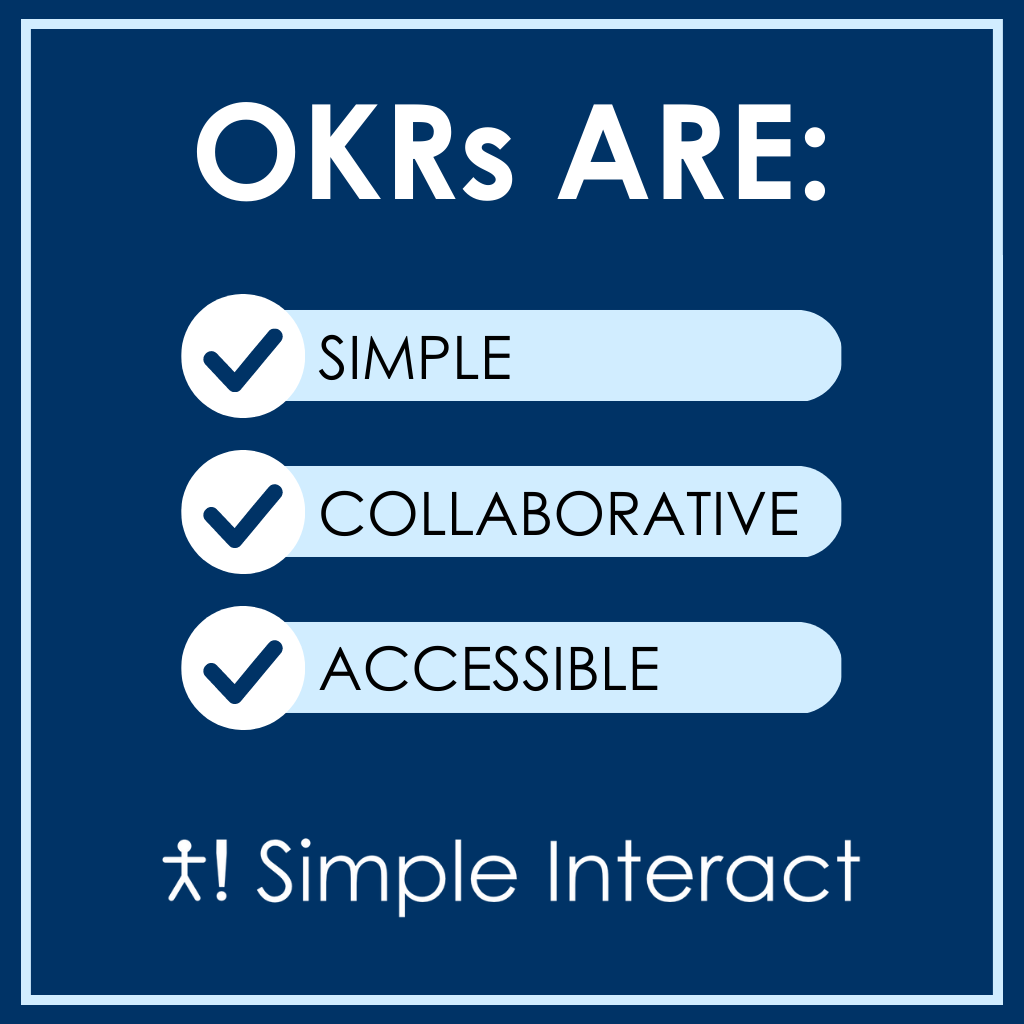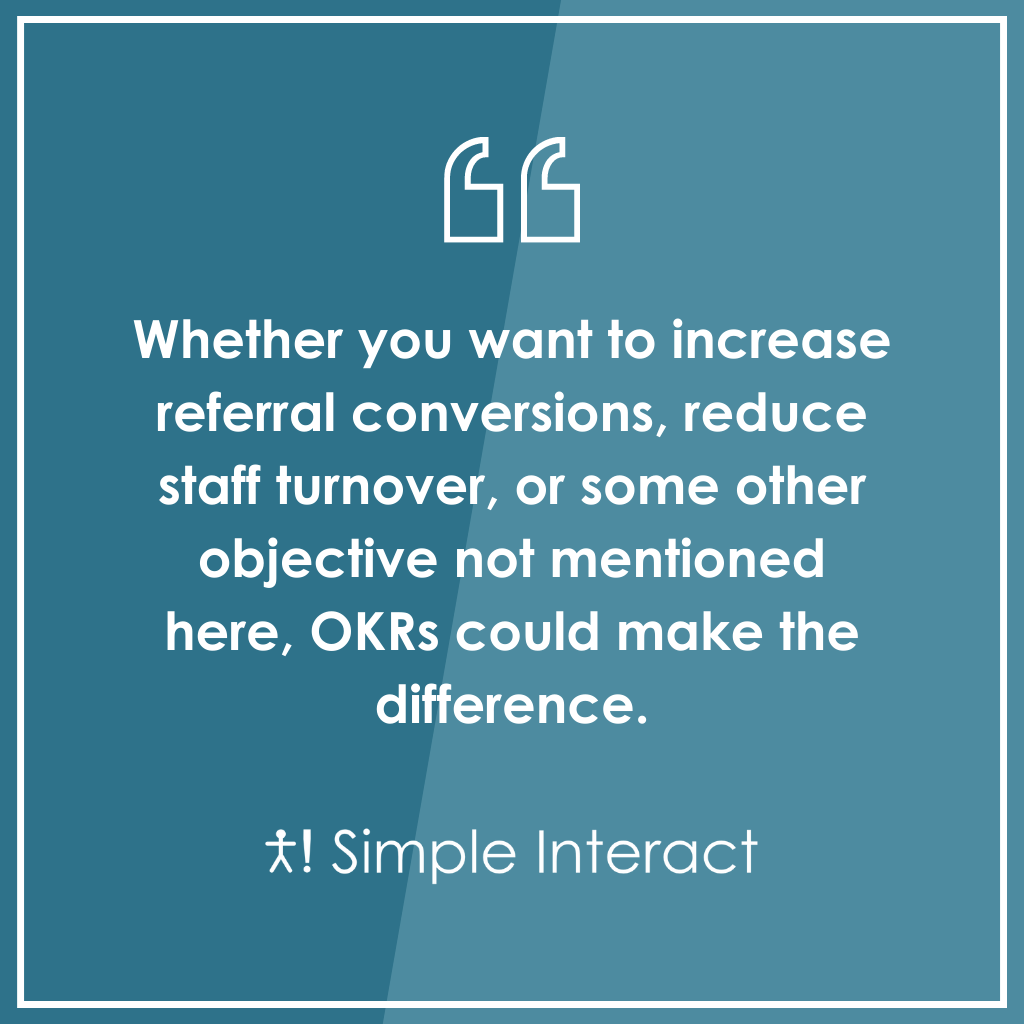How to Use OKRs to Achieve Your Healthcare Organization’s Objectives

All businesses, healthcare organizations included, have to improve over time if they want to grow and survive into the future.
That’s a given. But what’s the optimal way to do it? There are so many business optimization frameworks out there — SMART, KPIs, MBO, Lean Six Sigma, EOS, OKRs, and more. Is there really one right choice?
Not exactly. The framework you choose will depend on its applicability to the problems you need to address, your prior experience, budget, time, and other factors. And the internet is full of resources explaining the details, pros, and cons of every option.
That said, we’ve found one framework particularly useful at Simple Interact — OKRs — and we’d like to propose it as a refreshingly simple tool that our customers and many in the extended healthcare community could benefit from.
What Are OKRs and Why Use Them in Healthcare?
Simple Interact uses the Objectives and Key Results (OKR) target-setting framework internally, and we believe it could benefit all types of healthcare organizations — from hospitals to specialist practices.
The collaborative OKR framework helps businesses articulate their organization’s strategic goals, build a clear path to reach them, and set benchmarks to measure progress. Generally, OKR templates include an overall objective followed by three to five quantifiable key results that contribute to the overall goal.
We value OKRs within Simple Interact for a few of their specific qualities:
- Simple. OKRs are one of the most straightforward, direct, and clear goal-setting tools.
- Collaborative. OKRs allow you to involve the entire team when developing key results and action items.
- Accessible. Implementing OKRs requires little training and no consultation. You can start using it immediately and refine your process over time.
OKRs work best when setting goals for an entire organization or department rather than for individuals. However, we also like to include “action items” for specific individuals or team members to complete. This helps with transparency, accountability, and effectiveness.
In a complex industry like healthcare, simple solutions are valuable and reducing cost is a must. OKRs provide a way to make far-reaching changes in a straightforward, measurable, step-by-step manner without unnecessary additional spending.
In this post, we’d like to start a discussion around OKRs in healthcare and provide ideas and inspiration for any who would like to implement OKRs in their organization. Take a look at our examples below and see whether they might apply to your situation!

OKR Example From Inside Simple Interact
First, we’ll share an example of an OKR we’ve used within Simple Interact:
Objective
Monitor and improve our product performance for each customer.
Key Results
- Customer Service Advocates (CSAs) receive weekly progress reports for 100% of their assigned customers.
- CSAs alert customers within three days if they observe negative patterns.
- CSAs send hand-crafted quarterly reports to 100% of their assigned customers, including what’s working well, gaps in expected performance, and recommendations.
Action Items
- The user experience (UX) team will design how the weekly progress report looks.
- The engineering team will implement automated weekly progress reports by Q2 in 2022.
- CSAs will document the process of identifying negative patterns in reports and recommendations to correct the course.
- CSAs will design templates for quarterly reports by Q2 in 2022.
- CSAs will add quarterly reporting activities to their schedules.
OKR Examples for Healthcare Organizations
Next, let’s look at several example objectives healthcare organizations might already have in mind and how an OKR could look for each:
Objective 1: Reduce Staff Turnover
Most healthcare organizations would love to reduce staff turnover, but it’s a lot to tackle and involves many moving parts. Creating a straightforward OKR can help break the process into achievable action items with measurable results for each:
Key Results
- Obtain anonymous feedback from staff to identify opportunities for improvement.
- Reduce overtime hours by 25% at the end of 2023 to reduce the burden on staff.
- Add a monthly recognition program to highlight individual contributions.
- Improve the patient experience to reduce patient frustration aimed at staff members.
- Establish a competitive pay and benefits package to complement an enjoyable work environment.
Action Items
- Plan and implement a staff feedback process by the end of Q3 in 2023.
- Implement automated patient engagement, intake, and check-in processes by Q3 in 2023 to reduce overtime hours.
- Implement a monthly recognition program for staff by April 2023.
- Build an automated patient feedback process by the end of Q2 in 2023 and assign a patient liaison to handle negative feedback proactively.
- Establish a protocol for leadership to intervene to protect staff from abusive patient behavior.
- Hire a third-party advisor to review and make recommendations about the current pay and benefits package for employees.
Objective 2: Reduce Lost Revenue
Claim rejection, no-show patients, appointment leakage, penalties, and other sources of lost revenue can hamper your organization’s financial health.
Creating an OKR focused on reducing the various avenues of lost revenue can help:
Key Results
- Minimize claim rejections by 10% by the end of Q2 in 2023.
- Reduce no-show patients by 25% by the end of Q2 in 2023.
- Minimize appointment leakage by 15% by the end of Q3 in 2023.
- Avoid the 9% Medicare penalties (related to MIPS score) by the end of Q4 in 2023.
Action Items
- Update patient intake and check-in processes to ensure key data for claim submissions is captured consistently and correctly.
- Hire a third-party advisor to review and make recommendations to improve the current claims process.
- Implement an automated and integrated appointment reminder process to increase confirmation rate and reduce no-show patients.
- Modify policies to allow staff to cancel appointments if patients are unreachable and don’t adhere to the set expectations before their appointments.
- Implement a process for patients to request reschedules and a queueing mechanism that allows scheduling staff to accommodate these requests quickly.
- Create processes to consistently and accurately capture MIPS quality measures from patients without increasing the burden on staff.
Objective 3: Increase Referral Conversion From 20% to 50%
With the high importance of referrals for most healthcare organizations, one of your goals may be to improve your referral management process. If so, key results and action items like the following could prove helpful:
Key Results
- Reduce referral submission time to two minutes to make the process easier for referral sources.
- Increase the online reputation of each provider to four stars or more so referred patients don’t hesitate to book appointments.
- Respond to each referral submission within 30 minutes, since the conversion rate is higher when responses are prompt.
Action Items
- Replace fax and phone-based referrals with an online referral submission process.
- Update marketing materials and provide unique QR codes for each referral source to access their online forms.
- Implement an automated process to gather patient feedback and request online reviews.
- Implement a centralized dashboard for the referral management team to process and track all referrals.
Objective 4: Increase Provider Utilization by 2%
If you want to increase provider utilization, it’s important to improve operational efficiency overall. For example, getting patients to confirm their appointments and complete check-in steps ahead of time means providers aren’t left waiting while administrative work is completed.
You can consider key results and action items like the following:
Key Results
- Decrease no-show patients by 25% by the end of Q3 in 2023.
- Fill 40% of canceled appointment slots by the end of Q3 in 2023.
- Reduce average wait time from 30 minutes to 15 minutes.
- Get 80% of new patients to complete your intake form before their visit.
- Ensure 60% of new patients complete your check-in steps before their visit.
- Reduce manual data entry time per new patient from 20 minutes to five minutes.
Action Items
- Implement an automated and integrated appointment reminder process to increase the auto-confirm rate and reduce no-show patients.
- Create an automated process to fill canceled appointments with matching appointments on the future schedule.
- Implement an automated and integrated process for digital patient intake and check-in.
- Automate the process of pushing patient-entered data into the patient record in the electronic medical record (EMR).

OKRs for Healthcare Organizations
Whether you want to increase referral conversions, reduce staff turnover, or some other objective not mentioned here, OKRs could make the difference.
While we believe OKRs could be valuable tools in hospitals, medical practices, FQHCs, and more, we also hope to spur more consideration and conversation around simple tools that make a big impact on achieving goals in healthcare.
Simple Interact offers straightforward, easy-to-use solutions for patient engagement, patient access, task automation, and more to help healthcare facilities run as efficiently and profitably as possible. If you’d like to learn more about our services, reach out to request a demo.

Ravi Kalidindi is the Founder and CEO of Simple Interact, a leading Front Office Automation company that helps healthcare facilities across the United States run more efficiently and profitably by boosting staff productivity, reducing provider burnout, and elevating the patient experience. Customers view Ravi as a trusted partner who can quickly comprehend business problems and suggest “keep it simple” solutions that are effective and easier to maintain over time.
Recent Posts
- The Benefits of Using 2-Way SMS Chat for Healthcare Communication
- 2-Way SMS vs. Live Chat: Which Is Best for Bi-Directional Patient Communication?
- Simple Interact Earns A+ Satisfaction Ratings in KLAS Report
- Boosting Healthcare Staff Productivity With a Shared Inbox Dashboard
- Healthcare SMS: What Metrics to Track in Your 2-Way SMS
Categories
Archives
- February 2025
- June 2024
- May 2024
- April 2024
- March 2024
- February 2024
- January 2024
- December 2023
- November 2023
- October 2023
- September 2023
- August 2023
- July 2023
- June 2023
- May 2023
- April 2023
- March 2023
- February 2023
- January 2023
- December 2022
- November 2022
- October 2022
- September 2022
- August 2022
- July 2021
- December 2020
- May 2020
- March 2020
- June 2016